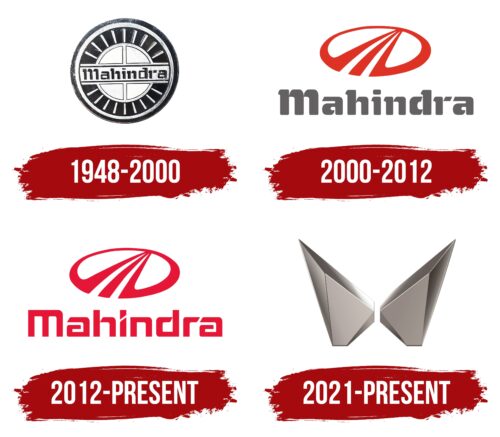The Mahindra logo resembles a fragment of an unknown metal from the future. The symbol emphasized the company’s past when it exported steel to India. Flowing from one shape to another, the emblem embodies the conglomerate’s flexibility and wide range of operations.
Mahindra: Brand overview
Mahindra’s story began on October 2, 1945, when Jagannath Chand Mahindra, Kailash Chand Mahindra, and Malik Ghulam Muhammad founded a company in Ludhiana, starting with steel trading. In 1948, after Muhammad’s departure, the company became Mahindra & Mahindra, shifting focus to assembling Willys jeeps for India.
The 1950s and 1960s saw the company diversifying into tractors, light commercial vehicles, and agricultural machinery, quickly rising as a leader in these segments. The 1970s and 1980s brought further expansion into construction equipment and energy systems, marking the start of international exports.
The 1990s solidified the company’s presence in the Indian automotive market with new SUV models like the Mahindra Armada and Mahindra Bolero, alongside ventures into IT services and software. The 2000s marked global ambitions with the acquisition of South Korean SUV manufacturer SsangYong Motor, establishing the company as a global player. The company also ventured into financial services, real estate, and renewable energy.
The 2010s saw continued global expansion, with new manufacturing facilities and research centers. Heavy investments in electric vehicles and autonomous technology positioned the company as a leader in sustainable mobility. Iconic models like the Scorpio, Bolero, and XUV500 bolstered its SUV market presence, while strategic acquisitions enhanced its capabilities in electric transportation.
Today, the company is one of India’s largest and most diversified conglomerates, operating in over 100 countries. It excels in the automotive industry, offering a wide range of passenger and commercial vehicles alongside agricultural and construction machinery. The company dominates the Indian automotive scene, particularly in SUVs, tractors, and commercial vehicles, boasting an estimated value exceeding $19 billion.
The company’s dedication to innovation, quality, and sustainability fuels its success and expansion, securing its role as a key global player and a pillar of the Indian economy.
Meaning and History
What is Mahindra?
Mahindra is an Indian multinational company renowned for producing a diverse range of vehicles, including SUVs, trucks, electric cars, agricultural machinery, and tractors. Because of their ruggedness and reliability, Mahindra’s vehicles cater to various markets.
1948 – 2000
The first Mahindra logo is rich with Indian motifs, giving it a unique national flavor. The main element of the logo is a circle with inner stripes resembling the spinning wheel depicted on the Indian flag. This symbol emphasizes the company’s deep connection to its home country and respect for national culture.
The company name, derived from the last names of two of the three founders, Kailash Chandra Mahindra and Jagdish Chandra Mahindra, is at the center of the logo. After the third founder, Malik Ghulam Muhammad, left the company, the brand was often called Mahindra & Mahindra, highlighting the names of the two brothers who remained at the helm.
The emblem resembles a tractor wheel, symbolizing the company’s primary activity area. Mahindra is a global leader in tractor manufacturing, and this logo element underscores its significance in this industry. The tractor wheel serves as a reminder that the company respects its roots while striving for technological excellence in agricultural machinery production.
2000 – 2012
With the opening of a new factory and the start of SUV production, the company logo was updated to highlight this new development phase. The new emblem is a circle with three stripes converging on the horizon. This shape hints at the image of a steering wheel, symbolizing control and management, which are key qualities for SUVs.
The inner stripes in the logo resemble a high-speed highway, representing the company’s new vehicles racing forward. This element emphasizes the drive toward progress and the future. The dynamic lines point to the leadership of the new cars on the road, their excellent performance, and their ability to overcome any obstacles.
The brand name is placed below the circle, completing the logo’s composition and creating a cohesive and harmonious look.
2012 – today
The well-known South Korean car brand SsangYong Motor Company became part of the company. This significant event was marked in the logo with bright colors, which also feature the company name. The red symbolizes victories, achievements, and continuous growth, reflecting the company’s dynamic development and drive toward new heights.
The red color also highlights the company’s success in various industries. The company is represented in 20 industries, demonstrating its versatility and strong production base. This solid foundation ensures the company confidently looks to the future without plans to stop.
The rest of the emblem’s design remains unchanged, retaining recognizable features and elements that symbolize stability and reliability.
2021 – today
The logo introduced in 2021 looks very modern and futuristic. Two multifaceted shapes in the logo mirror each other. They are made from an unusual metal and resemble butterfly wings. These elements symbolize the two founders, Kailash Chandra Mahindra and Jagdish Chandra Mahindra. Their collaboration created a world-class conglomerate that became a significant player on the international stage.
The logo’s central element is a bright light shining on the multifaceted shapes, symbolizing the opening of a pathway to the future. This light emphasizes the company’s commitment to innovation and progress and its vision for further development.
Mahindra is a pillar of India’s automotive industry and is important in the global automotive market. Its sales span 100 countries, demonstrating the high level of trust and recognition the brand enjoys worldwide.








